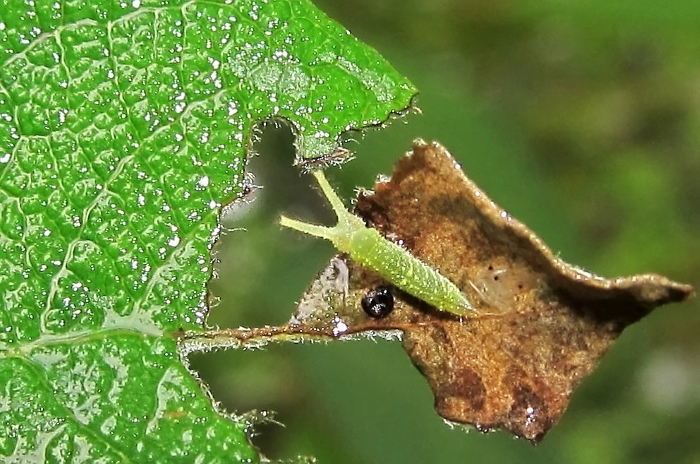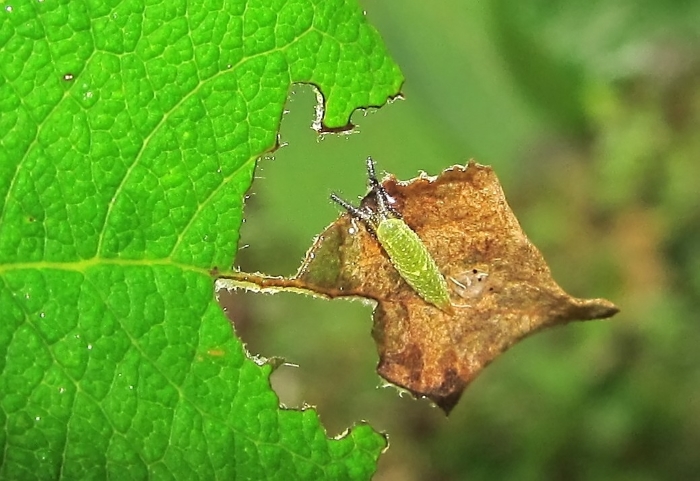Page 1 of 1
What's going on here?
Posted: Sun Jun 20, 2021 5:15 pm
by Padfield
Not a butterfly post, but one of you will be able to answer the question!
Last night, I cut some Swiss chard for supper and while washing it noticed what I thought were large white eggs on the point of hatching - a small clump of yellow skittles, some with blackheads. So I tore that bit of leaf off and attached it, still wet, to a leaf on a living chard plant in the hope the cats could hatch and get onto fresh greenery (I'm happy to share

). When I checked this evening, I saw I had misidentified the eggs - they were obviously ladybird eggs. But among them were creatures that were definitely not ladybird larvae. Can anyone tell me what is going on here?


Is there carnivorous activity happening here, and if so, who is eating whom? I wish I had taken a photo of the eggs last night but I was cooking and it was raining!
Guy
Re: What's going on here?
Posted: Sun Jun 20, 2021 10:05 pm
by Vince Massimo
Hi Guy, I don't claim to know anything about this, but if you search for "Ladybird eggs hatching" you will see lots of images similar to yours. I think they are either moulting their skins as soon as they emerge from the egg or their appearance changes dramatically very soon after hatching. I would like to know more about it myself.
Vince
Re: What's going on here?
Posted: Mon Jun 21, 2021 11:20 am
by Padfield
Thanks, Vince. I think you must be right. Today, they all seemed to be ladybird larvae - some dispersing, presumably after having eaten the eggs as their first meal.


The phenomenon reminds me of the 1st-2nd instar moult of purple emperors. Immediately on moulting, the horns are pale, soft and pliable. An hour later they are dark and more rigid:


(the 'broken' horn is an illusion caused by refraction through a water droplet)
Guy
Re: What's going on here?
Posted: Mon Jun 21, 2021 4:18 pm
by bugboy
Hi, I saw this thread last night but was too busy to comment (and to be honest I didn't really have a clue what was going on either). I've dug out my
Bloomsbury wildlife guide to British Ladybirds and found this:
The cannibalistic behaviour of ladybirds has been well studied, and occurs mainly in the larval stages.It is critical that a newly hatched larvae feeds as quickly as possible. For non predatory species this can be straight forward, the plant and mildew feeders are likely to be surrounded by easily accessible food. However, a tiny predatory larva might be the same size or smaller than the prey it finds itself surrounded by. It's quite remarkable to watch a small predatory ladybird larva riding on the back of an aphid as it feeds voraciously. Some larvae don't wait to find food but instead turn on their siblings hatching around them. This can improve the survival chances and reduce the development time of the ladybird larvae.
The next bit in the paragraph I had to read twice and I think is what is going on in Guys images, given that some (the yellow ones) look distinctly embryonic.
Some larvae hatch within an egg cluster in which only females are viable; their mother carries a bacterium within her cells that can only be transmitted from mother to daughter, and so to maximise transmission all the male embryos are killed by the bacterium. these so called 'male-killing bacteria' are intriguing and, although it seems a macabre life-history strategy, the hatching females benefit enormously from the consumption of a dead brother. 
Re: What's going on here?
Posted: Mon Jun 21, 2021 4:40 pm
by Padfield
Thanks Buggy. That's fascinating. I actually have that book and looked at the section on life histories but didn't see the paragraph you quote from, which is in the bit on feeding.
You are right that the yellow-legged thingies look rather embryonic. It certainly seems possible they are dead or dying males, being eaten by the mass of females. It's not impossible the females are eating each other too, as they remained in that pile of bodies and are still there this evening. I don't think I killed or harmed any of them when I washed the chard leaves as I only used cold water and stopped as soon as I saw the eggs (and there weren't nearly so many hatched then, if any). Eating each other will definitely increase their survival chances, as they will now need to go wandering perhaps a very great distance in search of other prey. I don't think there are any aphids on their chard plant at the moment.
What amazing things go on out there that we are totally unaware of.
Guy
Re: What's going on here?
Posted: Mon Jun 21, 2021 9:27 pm
by Vince Massimo
Thanks Paul, that's quite amazing.
Vince
 ). When I checked this evening, I saw I had misidentified the eggs - they were obviously ladybird eggs. But among them were creatures that were definitely not ladybird larvae. Can anyone tell me what is going on here?
). When I checked this evening, I saw I had misidentified the eggs - they were obviously ladybird eggs. But among them were creatures that were definitely not ladybird larvae. Can anyone tell me what is going on here?






